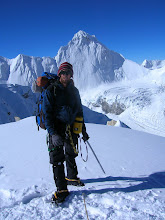Looking around and seeing nothing but ice while suffering from dehydration is a bit perplexing for the weary high altitude climber. My only choice was to continue to work my way down through the giant maze of the Icefall. Slowy and methodically was my aim. After working my way through the "Popcorn", one of the most turbulent portions of the Icefall, I traveled just underneath some huge seracs hanging precariously to Everest's West Shoulder. This was the spot of a fatality last year. A huge avalanche of snow and ice fell from this spot and swept a climber to his death while leading to the emergency evacuation of two other climbers who were a bit more fortunate. A right turn here, a left turn there. Up a 10 foot ladder and then a 30 foot rappel. All leading to a relatively safe zone, still well within the limits of the icefall and a little safer from falling ice.
Just when I thought fatigue might get the better of me I rounded a huge valley of ice and there stood Sheree, one of our awesome cookstaff from basecamp. He had climbed part-way into the Icefall with a nice, big, refreshing, thermos of HOT water! Ugghh! I am so thirsty. Why hot water, I asked myself? However, this hero had just put his life in a little danger and I made sure he saw nothing but gratitude coming from me. My entire Everest expedition would not have been possible without the awesome efforts of our Sherpa staff. They are always smiling and always willing to lend a helping hand. As thirsty as I was, I could only manage a small sip of water. What I really wanted was some cold juice. I heartily thanked Sheree for his efforts and I continued down.
Another 30 minues of bone-jarring effort brought me to yet another maze of 25 foot tall blades of ice. They looked more like gigantic shark's fins jutting out of the lower Icefall. After turning another corner my favorite Sherpa of all, Bala, was standing there smiling. He wrapped his arms around and gave me a great big hug. The hug was nice but I could not help but see something lying in the ice next to him. He had another thermos. I sheepishly asked him what was inside? Juice, was his reply. Cold, I asked? Yes. Whooohooo! Give me some of that! I quickly drank four glasses making sure to leave some for my teammates still higher on the hill. I thanked Bala for his wonderful efforts and with renewed strength I continued down. Basecamp was now in sight and I began to breath a sigh of relief.
Upon walking back to basecamp I was greeted with hugs, handshakes, and more importantly, cold juice. I was so overwhelmed. I looked back up into the icefall and I could see the tiny dots that were my teammates. I whispered a prayer of thanksgiving. I knew that I was blessed. I had done it! I had safely stood on top of the world and made it back down alive. My happiness felt a bit selfish because I new that not all of my teammates had made it down. I had hoped that the helicopter rescued Mike. I prayed that the helicopter had rescued Mike. Two hours later Phil walked back into basecamp. His head hung low. The tireless effects of what had transpired over the last 48 hours. I asked about Mike and the rescue. Did it happen? Is he safe? Our eyes met and that was enough for me to know the answer.






























